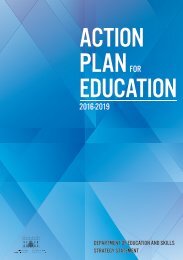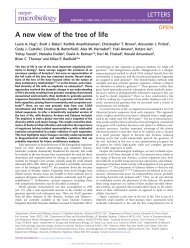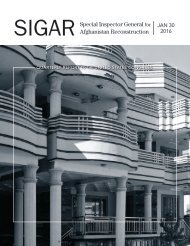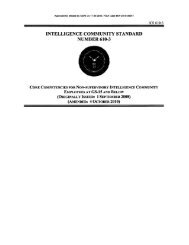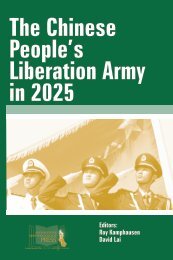The Joint Force in a Contested and Disordered World
JCS-JOE-2035
JCS-JOE-2035
You also want an ePaper? Increase the reach of your titles
YUMPU automatically turns print PDFs into web optimized ePapers that Google loves.
Conclusion<br />
“<strong>The</strong> primary purpose of any theory is to clarify concepts <strong>and</strong> ideas that have become, as<br />
it were, confused <strong>and</strong> entangled.” 41<br />
Although war is itself an endur<strong>in</strong>g feature of the human condition, the character of war is always<br />
evolv<strong>in</strong>g. This change <strong>in</strong> the character of war dem<strong>and</strong>s our attention. <strong>The</strong> emerg<strong>in</strong>g security<br />
environment can be described by simultaneous <strong>and</strong> connected challenges – contested norms <strong>and</strong><br />
persistent disorder. <strong>The</strong> evolution of these challenges <strong>in</strong> the security environment of 2035 will be<br />
evident across <strong>World</strong> Order; Human Geography; <strong>and</strong> Science, Technology, <strong>and</strong> Eng<strong>in</strong>eer<strong>in</strong>g.<br />
Competitor states <strong>and</strong> some powerful non-state actors will challenge the rules that underp<strong>in</strong> the<br />
current global order. Meanwhile, fragile states will become <strong>in</strong>creas<strong>in</strong>gly <strong>in</strong>capable of ma<strong>in</strong>ta<strong>in</strong><strong>in</strong>g<br />
order. Moreover, anticipated scientific <strong>and</strong> technical advances will likely lead to greater parity<br />
among a range of <strong>in</strong>ternational actors thus allow<strong>in</strong>g potential adversaries to more effectively<br />
challenge U.S. global <strong>in</strong>terests.<br />
Trends <strong>and</strong> conditions will converge <strong>and</strong> <strong>in</strong>tersect, creat<strong>in</strong>g six specific Contexts of Future Conflict<br />
that describe the character of future conflict, the nature of potential adversaries, <strong>and</strong> the<br />
characteristics of the military competitive space. Future conflict will feature more capable<br />
adversaries plac<strong>in</strong>g difficult dem<strong>and</strong>s on the <strong>Jo<strong>in</strong>t</strong> <strong>Force</strong> over wide areas of the globe. Furthermore,<br />
the effectiveness <strong>and</strong> susta<strong>in</strong>ability of <strong>Jo<strong>in</strong>t</strong> <strong>Force</strong> operations over time will be highly dependent<br />
on popular perceptions, attitudes, <strong>and</strong> broad acceptance of their legitimacy.<br />
When l<strong>in</strong>ked to an underst<strong>and</strong><strong>in</strong>g of the potential range of future U.S. strategic goals <strong>and</strong> endur<strong>in</strong>g<br />
military tasks, the Contexts of Future Conflict enable the identification of likely <strong>Jo<strong>in</strong>t</strong> <strong>Force</strong><br />
missions. <strong>The</strong> scope of these missions reflects the need to simultaneously address high-end threats<br />
to favorable global order with the need to confront disruptive low-end threats emerg<strong>in</strong>g from a<br />
disordered world. However, the missions should not be viewed as a clearly def<strong>in</strong>ed, precise, <strong>and</strong><br />
discrete set, but rather, a start po<strong>in</strong>t for a dialogue between military planners <strong>and</strong> their political<br />
leaders.<br />
<strong>The</strong> outcome of this dialogue will be shaped by the force development activities of today. It is<br />
unclear whether the <strong>Jo<strong>in</strong>t</strong> <strong>Force</strong> can be simultaneously proficient at address<strong>in</strong>g contested norms<br />
<strong>and</strong> persistent disorder with currently projected capabilities, operational approaches, <strong>and</strong> fiscal<br />
resources. <strong>The</strong>refore, the United States must consider military <strong>in</strong>vestments that acknowledge there<br />
may be times when it is more appropriate to manage global security problems as opposed to<br />
undertak<strong>in</strong>g expensive efforts to comprehensively solve them.<br />
JOE 2035 is designed to encourage the purposeful preparation of the <strong>Jo<strong>in</strong>t</strong> <strong>Force</strong> to effectively<br />
manage this reality. It sets the stage for a more detailed conversation about how the <strong>Jo<strong>in</strong>t</strong> <strong>Force</strong><br />
can achieve success <strong>in</strong> the future security environment. JOE 2035 was written to accelerate new<br />
ways – or concepts – for the <strong>Jo<strong>in</strong>t</strong> <strong>Force</strong> to address the likely needs of future strategy <strong>and</strong> thus,<br />
identify a foundation upon which endur<strong>in</strong>g U.S. military advantages can be built.<br />
41<br />
Carl Von Clausewitz, On War. (trans. Paret <strong>and</strong> Howard, 1976/1984), p. 132.<br />
52




